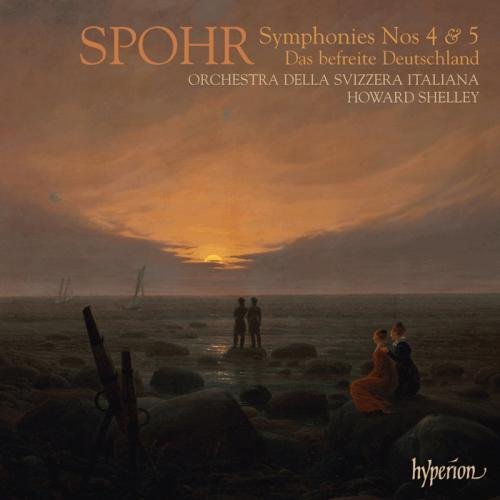Orchestra della Svizzera Italiana, Howard Shelley - Louis Spohr - Symphonies Nos 4 & 5; Overture 'Das befreite Deutschland' (2008)

Artist: Orchestra della Svizzera Italiana, Howard Shelley
Title: Louis Spohr - Symphonies Nos 4 & 5; Overture 'Das befreite Deutschland'
Year Of Release: 2008
Label: Hyperion
Genre: Classical
Quality: FLAC (image+.cue,log,scans)
Total Time: 78:22
Total Size: 321 Mb
WebSite: Album Preview
Tracklist: Title: Louis Spohr - Symphonies Nos 4 & 5; Overture 'Das befreite Deutschland'
Year Of Release: 2008
Label: Hyperion
Genre: Classical
Quality: FLAC (image+.cue,log,scans)
Total Time: 78:22
Total Size: 321 Mb
WebSite: Album Preview
Louis Spohr (1784–1859)
[1] Overture ‘Das befreite Deutschland’ WoO 64
[2]-[5] Symphony No 4 in F major ‘Die Weihe der Töne’ Op 86
[6]-[9] Symphony No 5 in C minor Op 102
Performers:
Orchestra della Svizzera Italiana
Howard Shelley, conductor
Though held in high regard by many of his colleagues as being worthy of a pedestal next to Mozart, Haydn, and Beethoven in the pantheon of Western music’s great composers, Ludwig (Louis) Spohr (1784–1859), along with Christoph Read more Le nozze di Figaro and Wagner’s Tristan und Isolde were composed during Spohr’s lifetime.
Eight years younger than Rossini and 13 years Schubert’s junior, Spohr wrote music that is Janus-like, specifically it looks to the formalism and clarity of the Classicists and at the same time sows the seeds of Romanticism via its harmonic and structural experimentation. While it can occasionally become repetitious and to a degree mired in its own glories—a reason that probably was instrumental (pardon the pun) in its neglect for many years—Spohr’s music does have much to offer, including a fine sense of drama, an excellent command of the orchestra, and more than just the occasional memorable melody. Although Spohr was fond of employing chromaticism, its effective but frequent use has been the target of the slings and arrows of some of his detractors.
Almost a century and a half after Spohr’s death, it may be difficult for us to grasp why he was viewed as the spiritual and artistic successor to Beethoven, as we have become inundated with recordings of Mendelssohn and Schumann, perhaps losing sight of the fact that there was no gap in the timeline of the form between Beethoven and the true Romanticists. That said, we should take Spohr’s music in the context of the times and try not to view it from an entirely historical perspective, allowing it to be eclipsed by what was to be.
Spohr was a virtuoso violinist, completing 15 concertos for the instrument. One of those, the Concerto No. 8 in A Minor, op. 47, bears the subtitle “In the style of a vocal scene,” and has been taken up by several violinists over the years; the most recent recording appears to be that by Elisabeth Wallfisch on Helios 55157. Spohr’s 10 symphonies were written between 1811 and 1857. To give the reader points of reference, Spohr’s First Symphony was composed a year before Beethoven’s Seventh and Spohr’s final symphony came to fruition half a decade before Brahms began setting down sketches for his First Symphony.
The Fourth Symphony—like Spohr’s Sixth and Ninth— bears a programmatic subtitle, in this instance, “The Consecration of Sounds.” It is an hommage to Spohr’s friend, poet Carl Pfeiffer, and carries the name of a memorial collection of Pfeiffer’s poetry. The Fifth Symphony was my introduction to Spohr’s music; it came some three decades ago via the old Music from Germany radio series hosted by David Berger. The overture, whose title roughly translates into English as “The Liberation of Germany,” is pure patriotic fluff, but good fluff, composed in the wake of Napoleon’s defeat at Leipzig in 1813. Past that it is mostly inconsequential. My initial reaction to the Fifth Symphony was to wonder where this music has been all these years; and earlier this year, I was quite pleased to learn that Hyperion had initiated a new cycle of the symphonies. The effort is sorely needed as the old series on marco polo, though competent, lacked both the fervent advocacy and superior musicianship necessary to compel the attention of many listeners.
I favorably evaluated the first release in the cycle in Fanfare 31: 4 (March/April 2008) and am pleased to report that this outing also augurs well for the composer and the performers. Howard Shelley, an established virtuoso pianist, has been taking to the podium of late and is managing to carve out a successful second career. He exhibits a keen understanding of Spohr’s music and also has the ability to effectively communicate this to his orchestra. At the same time, Shelley doesn’t try to extract more from Spohr’s scores than is there. He takes the music for what it’s worth and leaves the final decision to the auditor. The orchestral playing is clean, clear, and crisp—with tempos that allow the music to unfold comfortably. The aural perspective mimics concert hall realism, but it also allows for Spohr’s lovely wind coloration too. The result is another Hyperion release that offers us further insight into the process of Spohr’s symphonic development.
I can’t imagine anyone not liking this disc, unless it is another of those musical bigots whose appetite is satiated only by a proliferation of Beethoven, Mendelssohn, and Schumann.
Eight years younger than Rossini and 13 years Schubert’s junior, Spohr wrote music that is Janus-like, specifically it looks to the formalism and clarity of the Classicists and at the same time sows the seeds of Romanticism via its harmonic and structural experimentation. While it can occasionally become repetitious and to a degree mired in its own glories—a reason that probably was instrumental (pardon the pun) in its neglect for many years—Spohr’s music does have much to offer, including a fine sense of drama, an excellent command of the orchestra, and more than just the occasional memorable melody. Although Spohr was fond of employing chromaticism, its effective but frequent use has been the target of the slings and arrows of some of his detractors.
Almost a century and a half after Spohr’s death, it may be difficult for us to grasp why he was viewed as the spiritual and artistic successor to Beethoven, as we have become inundated with recordings of Mendelssohn and Schumann, perhaps losing sight of the fact that there was no gap in the timeline of the form between Beethoven and the true Romanticists. That said, we should take Spohr’s music in the context of the times and try not to view it from an entirely historical perspective, allowing it to be eclipsed by what was to be.
Spohr was a virtuoso violinist, completing 15 concertos for the instrument. One of those, the Concerto No. 8 in A Minor, op. 47, bears the subtitle “In the style of a vocal scene,” and has been taken up by several violinists over the years; the most recent recording appears to be that by Elisabeth Wallfisch on Helios 55157. Spohr’s 10 symphonies were written between 1811 and 1857. To give the reader points of reference, Spohr’s First Symphony was composed a year before Beethoven’s Seventh and Spohr’s final symphony came to fruition half a decade before Brahms began setting down sketches for his First Symphony.
The Fourth Symphony—like Spohr’s Sixth and Ninth— bears a programmatic subtitle, in this instance, “The Consecration of Sounds.” It is an hommage to Spohr’s friend, poet Carl Pfeiffer, and carries the name of a memorial collection of Pfeiffer’s poetry. The Fifth Symphony was my introduction to Spohr’s music; it came some three decades ago via the old Music from Germany radio series hosted by David Berger. The overture, whose title roughly translates into English as “The Liberation of Germany,” is pure patriotic fluff, but good fluff, composed in the wake of Napoleon’s defeat at Leipzig in 1813. Past that it is mostly inconsequential. My initial reaction to the Fifth Symphony was to wonder where this music has been all these years; and earlier this year, I was quite pleased to learn that Hyperion had initiated a new cycle of the symphonies. The effort is sorely needed as the old series on marco polo, though competent, lacked both the fervent advocacy and superior musicianship necessary to compel the attention of many listeners.
I favorably evaluated the first release in the cycle in Fanfare 31: 4 (March/April 2008) and am pleased to report that this outing also augurs well for the composer and the performers. Howard Shelley, an established virtuoso pianist, has been taking to the podium of late and is managing to carve out a successful second career. He exhibits a keen understanding of Spohr’s music and also has the ability to effectively communicate this to his orchestra. At the same time, Shelley doesn’t try to extract more from Spohr’s scores than is there. He takes the music for what it’s worth and leaves the final decision to the auditor. The orchestral playing is clean, clear, and crisp—with tempos that allow the music to unfold comfortably. The aural perspective mimics concert hall realism, but it also allows for Spohr’s lovely wind coloration too. The result is another Hyperion release that offers us further insight into the process of Spohr’s symphonic development.
I can’t imagine anyone not liking this disc, unless it is another of those musical bigots whose appetite is satiated only by a proliferation of Beethoven, Mendelssohn, and Schumann.
![NYO Jazz - Live in Johannesburg (Live) (2025) [Hi-Res] NYO Jazz - Live in Johannesburg (Live) (2025) [Hi-Res]](https://www.dibpic.com/uploads/posts/2025-12/1765894703_zwp14vk90corb_600.jpg)

![Luizinho do Jêje, Marcelo Galter, Sylvio Fraga - Mocofaia (2024) [Hi-Res] Luizinho do Jêje, Marcelo Galter, Sylvio Fraga - Mocofaia (2024) [Hi-Res]](https://img.israbox.com/img/2025-12/19/ie15pqye9f7axu0oyf0ndsk7k.jpg)
![Dave Holland - Emerald Tears (1977/2025) [Hi-Res] Dave Holland - Emerald Tears (1977/2025) [Hi-Res]](https://www.dibpic.com/uploads/posts/2025-12/1765891427_cover.jpg)



![Eshon Burgundy - Safe Place (Bossa Nova Jazz) (2025) [Hi-Res] Eshon Burgundy - Safe Place (Bossa Nova Jazz) (2025) [Hi-Res]](https://www.dibpic.com/uploads/posts/2025-12/1766079194_cover.jpg)
